CHRYSOFORCE™ R
CHRYSOForce™ R
Also known as the green lacewing, Chrysoperla rufilabris.
They will eat anything and everything they can catch, and they are always hungry!
Does not control Root Aphids.
The Larvae Feed On
Many Aphid Species
Many Mealybug Species
Spider mites
Many Thrips Species
Whiteflies (eggs/juveniles)
Eggs of Many Pests Species
Ornamentals
Hemp/Cannabis
Vegetables
Soft Fruits
Tree nurseries
Greenhouses
Indoor Facilities
Fields
Gardens
Orchards

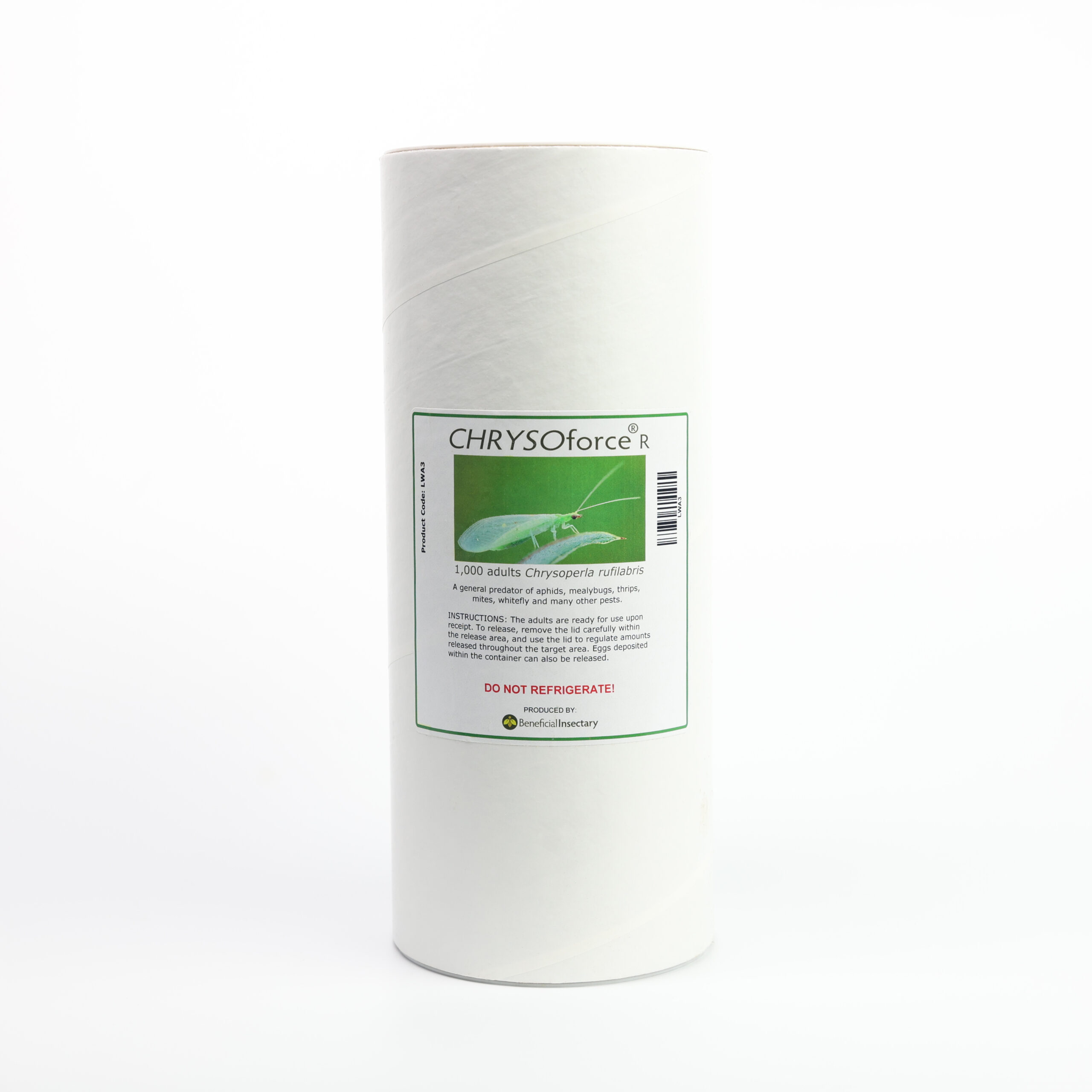

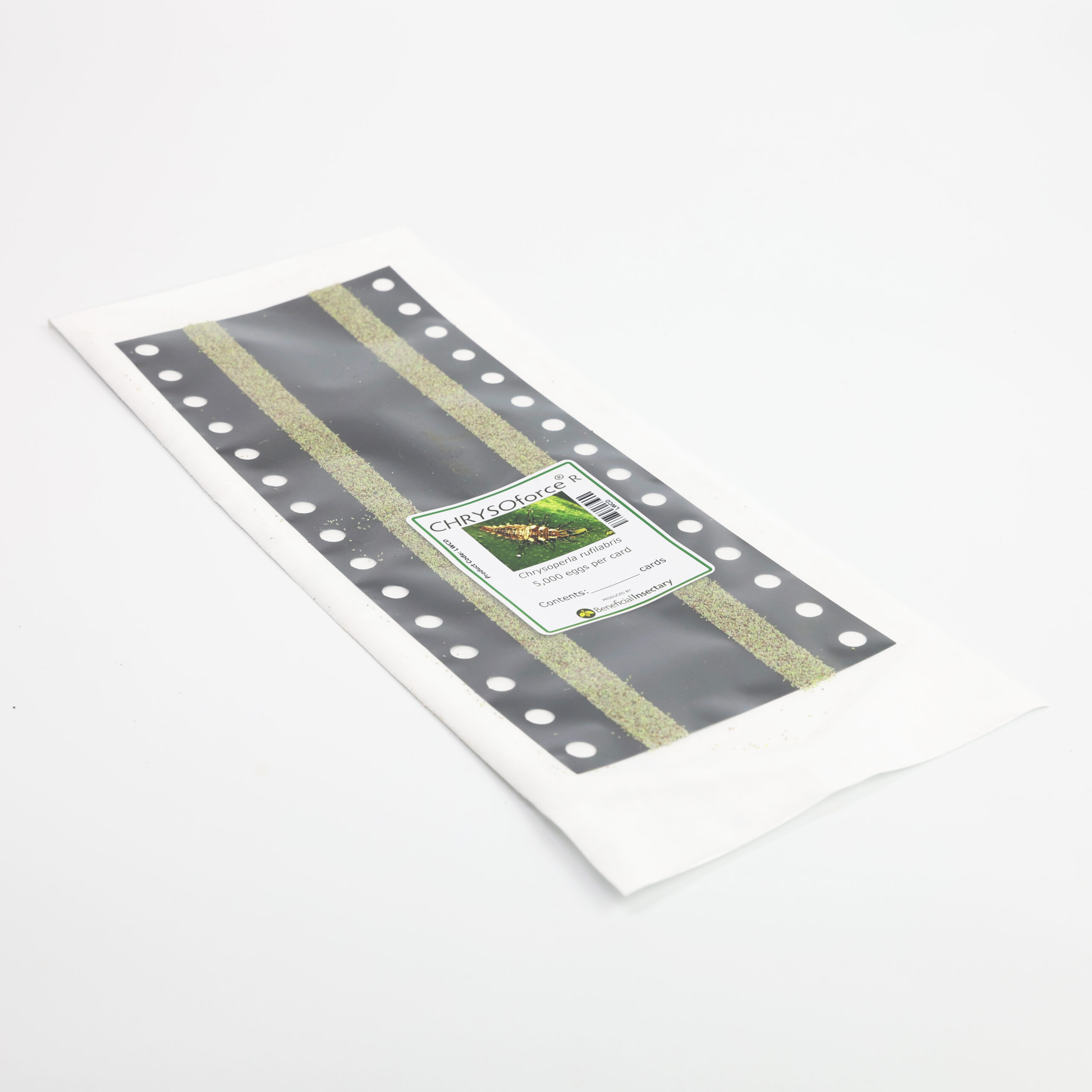
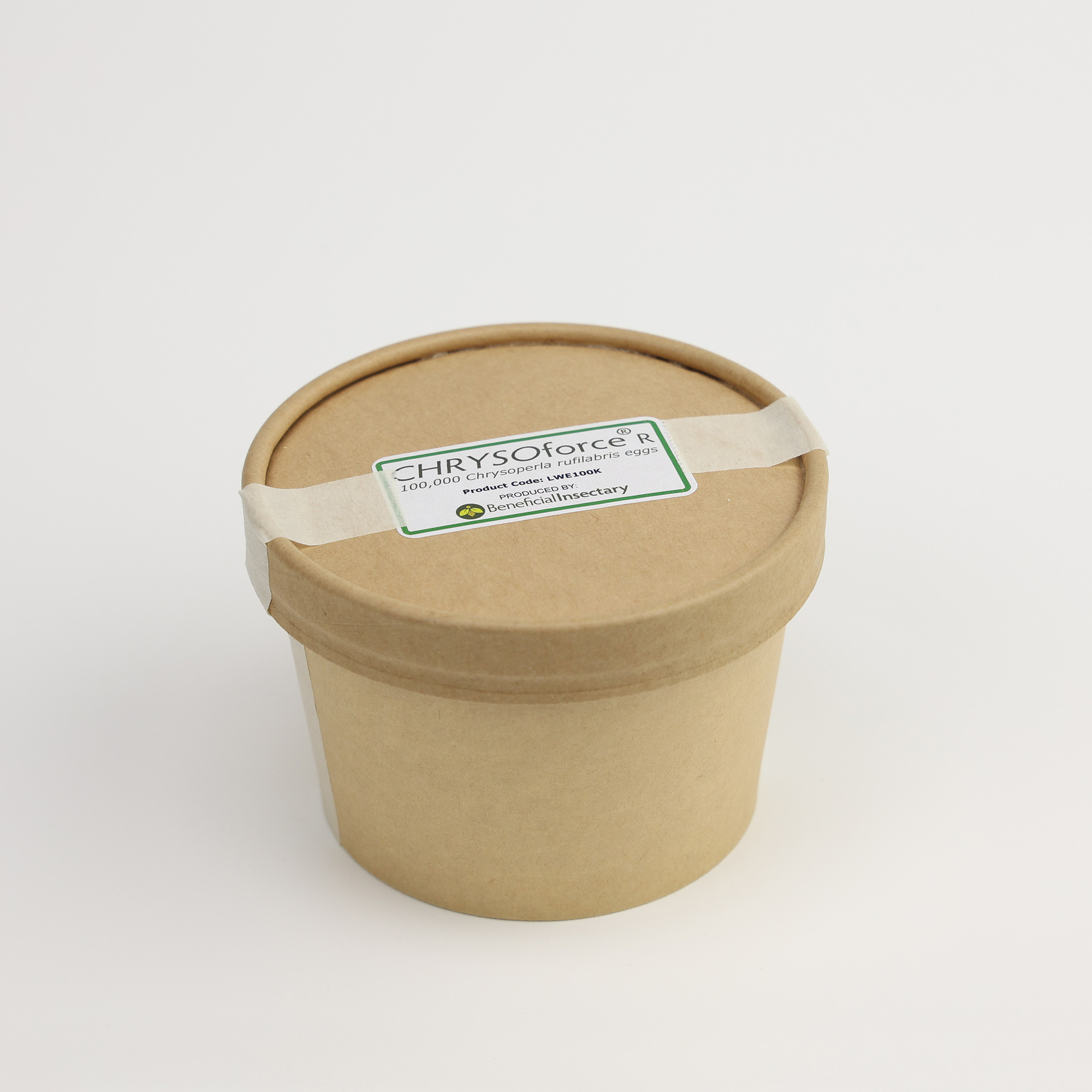
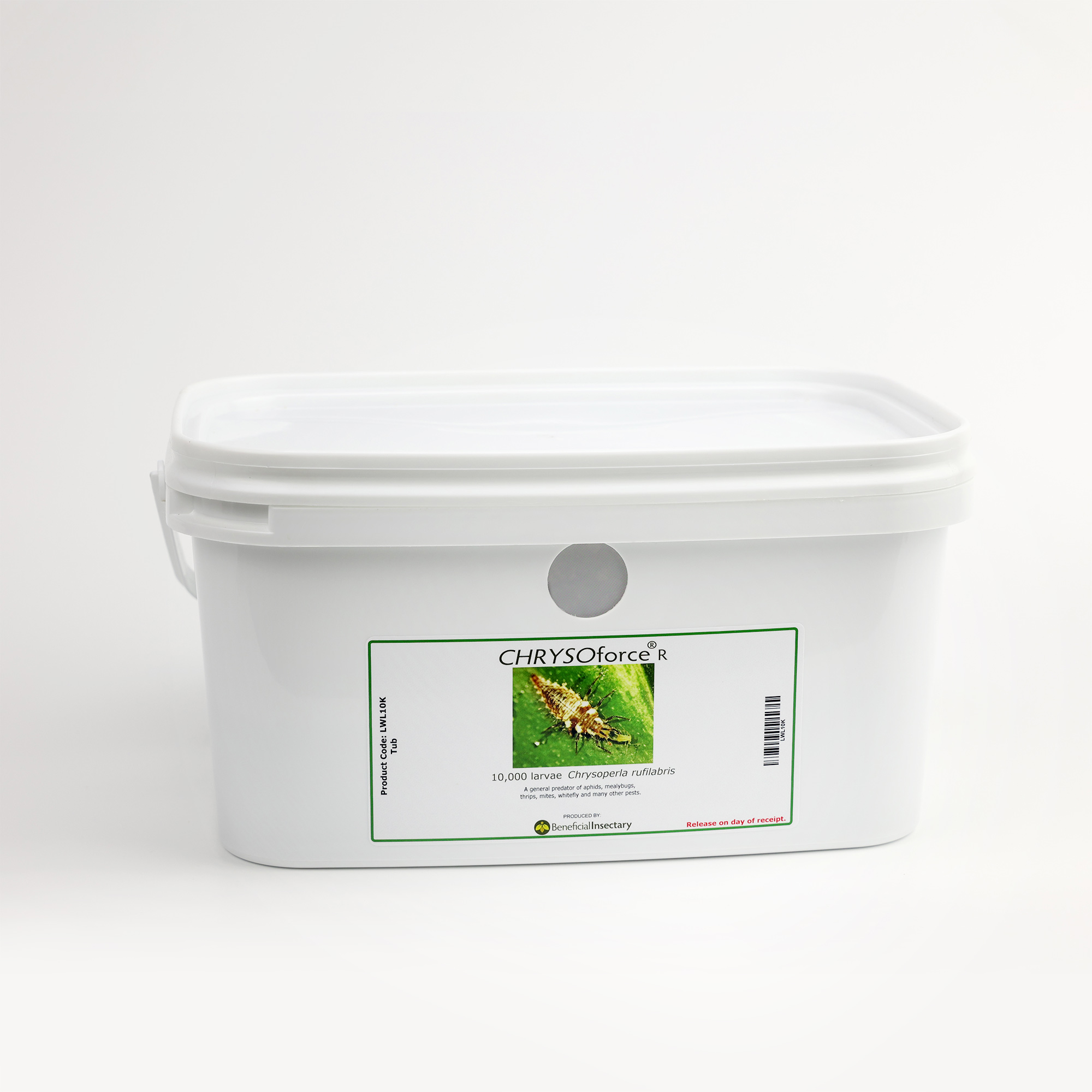

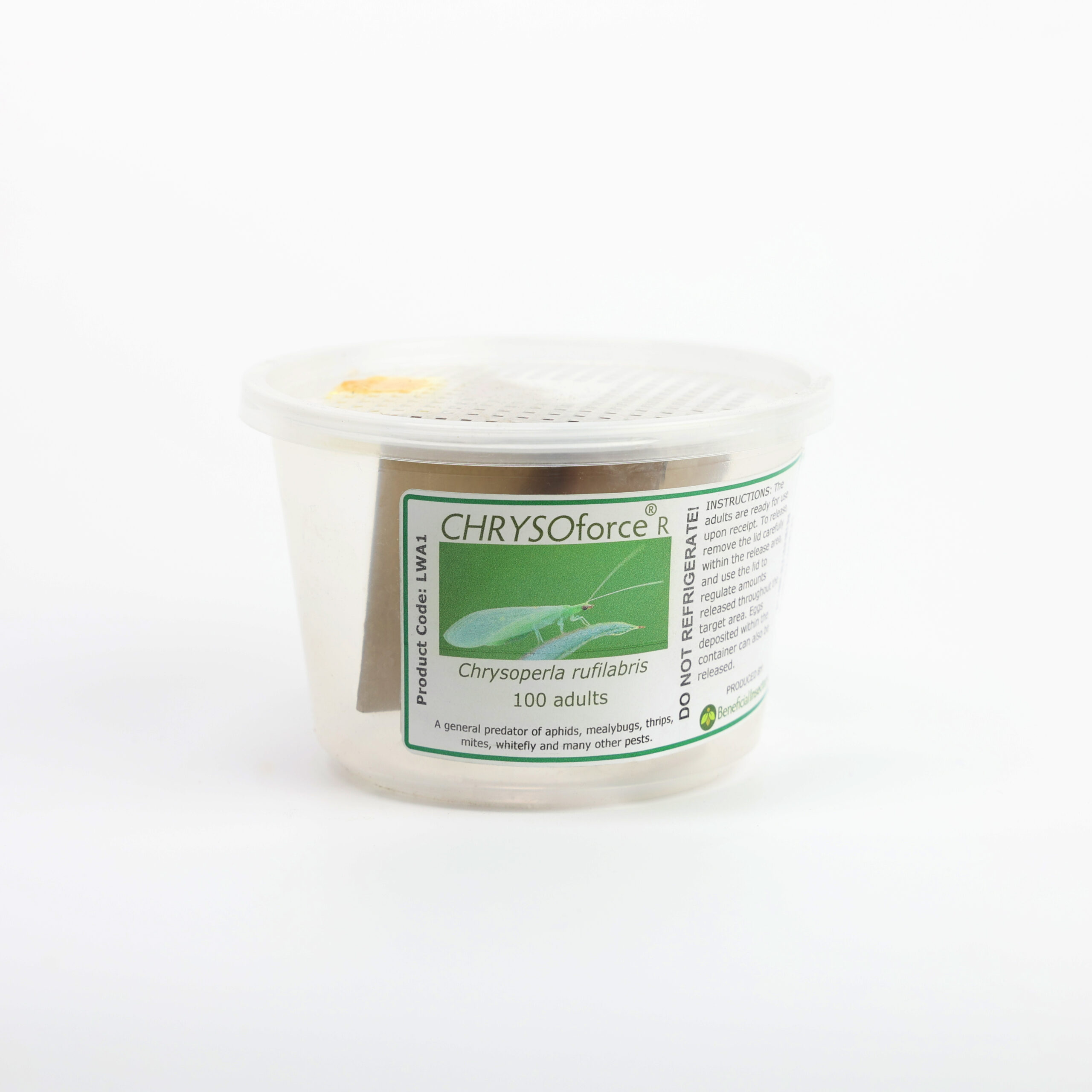

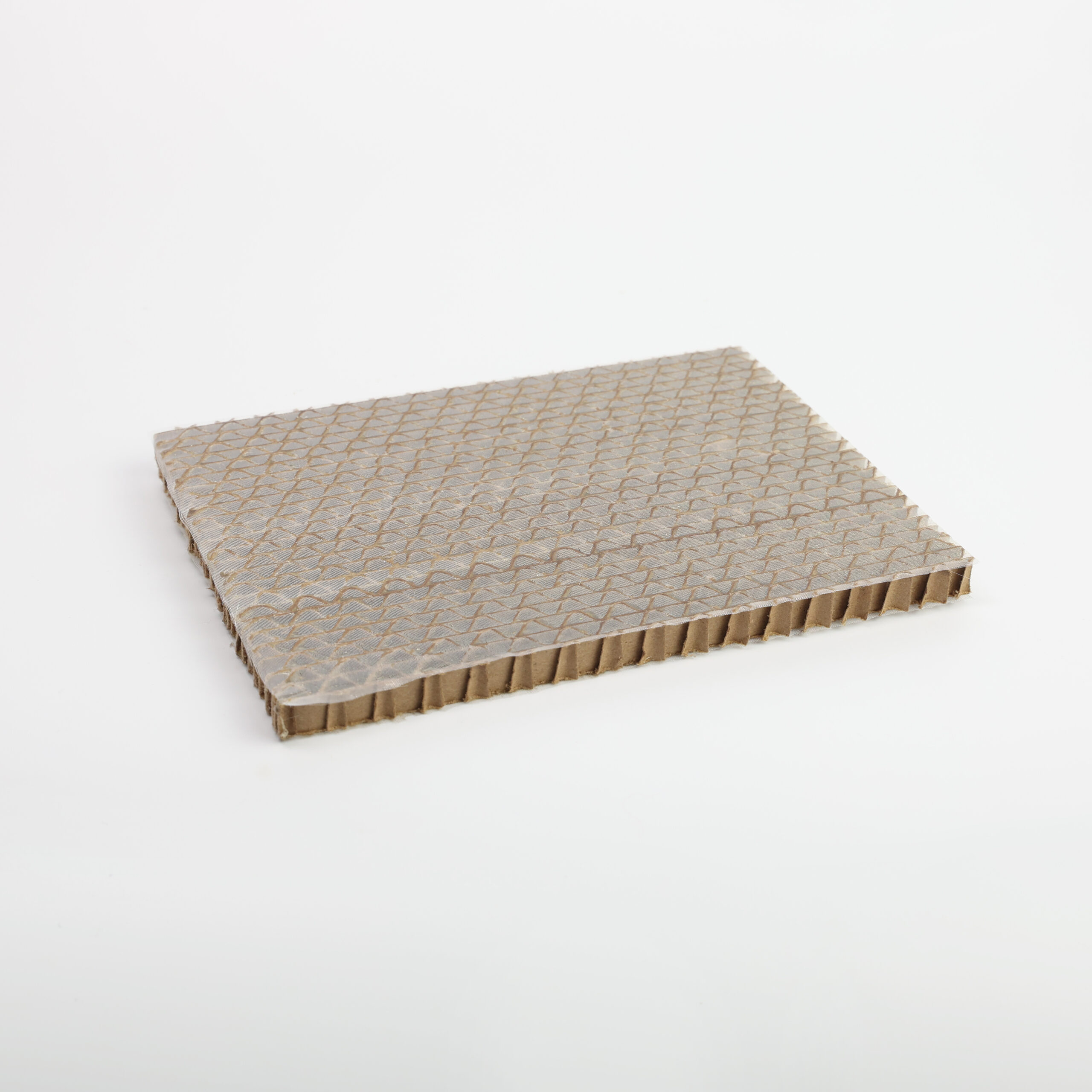
The larvae seek for prey and then suck the life out of them – consuming up to 50 aphids daily.
Females can lay up to 400 plus eggs near pest’s hot spots.
Capable of attacking large prey.
Remains active in low light and in cooler temperatures.
Do Not Cold Store the Larvae.
Eggs
Release eggs when newly hatched larvae are seen moving in the container. Eggs may be hatching upon arrival. During summer months, the larvae will emerge sooner. In any part of the year, it should take no longer than 3 days for hatching to occur, if held at around 80ׄ°F. Always rotate the bottle gently upon arrival to separate the lacewing eggs so they are not clustered in one area. Eggs are ready for immediate field release if:
1 – Egg membranes are dull gray.
2 – Abdominal bands of larvae are distinct.
3 – Larval eyespots are readily visible.
4 – At least 1% of the eggs have hatched.
Lacewing eggs are normally shipped in a container with rice hulls. This combination provides separation of eggs and enhances their distribution to places where pest infestation occurs. To release the eggs, simply sprinkle the contents of the container over the targeted plants but go easy; don’t sprinkle the complete contents in one spot. If the pest problem is persistent, you may want to apply lacewing eggs at pre-planned intervals (every one to two weeks).
Eggs On a Card
Each sheet of a lacewing card contains at least 5,000 viable eggs and food divided into 30 segments. To divide up the segments, turn the card over and either tare or use scissors to cut along the perforation. Release as soon as lacewing larvae start to hatch from the eggs. Eggs will turn from green to gray before hatching. Hang the segments near the pest infestation. Keep them in protected areas away from direct sunlight. Ant control is very important! They will be attracted to the eggs and food. Eggs will continue to hatch over a period of 24-48 hours. The segments can be moved to aid dispersal after about 12 hours. If the pest problem is persistent, you may want to apply lacewing eggs at pre-planned intervals (every two weeks).
Larvae – Bulk Bag or Bottle
Lacewing eggs are incubated at the insectary and upon arrival will have hatched into larvae. They are mixed with buckwheat for easy distribution and should be released the same day received. Simply sprinkle the contents over the target area. The bulk bag will come with a separate plastic scoop you can use to release the larvae.
Larvae – Hexcel Frame
Pre-fed lacewing larvae are still developing inside individual cells also known as a “rearing frame” covered on both sides with organdy material. You can observe the larvae in the cells if you hold the frame into the light. The larvae should be released the same day received (no later than the following day) unless otherwise stated on your packing slip. Peel back one side of the organdy material an inch at a time and “knock” or “tap” the larvae out onto the target area. Next, peel off the organdy on the other side of the frame. You can lay the organdy and frame next to a plant to ensure any remaining larvae can crawl out and onto the plant(s).
It is quite difficult to find the larvae in the crop – they’re small, fast, and do not want to be located.
The most opportune time to monitor this predator would be in the evening.
The biggest indication that CHRYSOforce™ R products are doing their jobs would be the lack of pests a few days after initial release.
If ants are present, ensure that they are controlled before releasing CHRYSOforce™ products. Aphids produce honeydew that the ants feed on. Because of this, ants will protect the aphids from the predators.
Adult lacewings need pollen, nectar, or other suitable food to breed and lay eggs. WHEAST™ can be given to the adult lacewings as a supplement.
Live-Product: Beneficial Insectary strives to guarantee the live delivery of the freshest organisms to our customers. We offer replacements or credits for any compromised shipments to our customers that report any issues or concerns within 24 hours. These issues or concerns must be relayed before releasing any organisms that are suspected of having viability issues. Please do not discard the product. You may be requested to return the shipment for further analysis.
Establishment of BCAs in Crop Settings: Many variables can negatively or positively impact BCA and pest populations in various crops we work with (pesticide applications, watering practices, improper storage methods, cultural/physical/mechanical controls, etc.). Some beneficial organisms require a steady pest presence as a food source to build their population. Others may require alternate food sources, such as pollen or nectar as an example. While other BCAs have specific photoperiod requirements for success. Due to these variables, we cannot guarantee the long- or short-term establishment of the BCAs we sell after the release of the organism(s). We will not offer refunds, discounts, or other credits on products that have already been released. Please adhere to our “Live-Product” disclosure.
QUICK START GUIDE
PRODUCT RELEASE METHOD
PRODUCT SPECIFICATIONS
PRODUCT | PACKAGE SIZE Filler/Carrier | LIFE STAGES | PRODUCT CODE |
|---|---|---|---|
CHRYSOforce™ R – 5,000 | 4oz Bottle w/ Rice Hulls | Eggs | L5K |
CHRYSOforce™ R – 10,000 | 8oz Bottle w/ Rice Hulls | Eggs | L10K |
CHRYSOforce™ R – 5,000 | Card – No Carrier or Filler | Eggs | LWCD |
CHRYSOforce™ R – Bulk | 8oz Cup – No Filler or Carrier | Eggs | LWE |
CHRYSOforce™ R – 100,000 | 8oz Cup – No Filler or Carrier | Eggs | LWE100K |
CHRYSOforce™ R – 400 |
6×8 Hex Cell Frame |
Larvae | LWFR |
CHRYSOforce™ R – 1,000 |
16oz Bottle w/ Buckwheat | Larvae | LWB |
CHRYSOforce™ R – 5,000 | 5 Liter Bag w/ Buckwheat | Larvae | LWBG |
CHRYSOforce™ R – 10,000 | 5 Liter Bucket w/ Buckwheat | Larvae | LWL10K |
CHRYSOforce™ R – 100 | 32oz Cup – No Filler or Carrier | Adults | LWA1 |
CHRYSOforce™ R – 250 | 32oz Cup – No Filler or Carrier | Adults | LWA2 |
CHRYSOforce™ R – 1,000 | Tube – No Filler or Carrier | Adults | LWA3 |
RELEASE RATES
CLASSIFICATION | RELEASE INFORMATION |
|---|---|
Preventative | 1-3 per 10 sq. ft., monthly, as needed |
Low | 2-5 per 10 sq. ft., bi-weekly, 2-3 times |
Medium | 4-8 per 10 sq. ft., weekly, 2-4 times |
High | 1 per sq. ft., bi-weekly, 3-5 times |
Maintenance | 1-2 per 10 sq. ft., tri-weekly, indefinitely |
Garden | 60-90% of rates listed |
Acre+ | 20-50% of rates listed |
Comments | Rates shown are for larvae. If you’re using eggs, multiply the calculated rate by five (5). If employing adults, divide the calculated rate by four (4). |

CANNABIS ALERT: Release rate suggestions on these pages are usually not sufficient for cannabis growers. For cannabis release rates contact us.
Life Cycle
EGG STAGE
- 3-6 days
LARVAL STAGES
- 2-3 weeks (3 Larval Stages)
- Larvae can travel 4-5km before becoming adults
PUPA STAGE
- 2-3 weeks (3 Larval Stages)
- Larvae can travel 4-5km before becoming adults
ADULT
- Not Predatory
